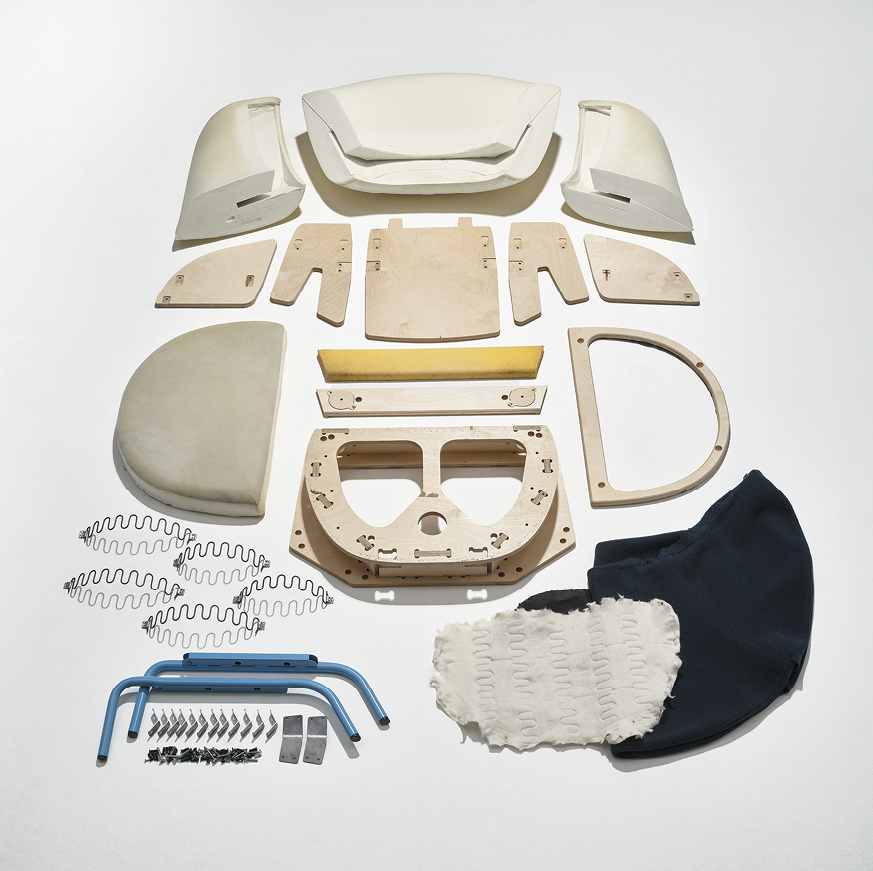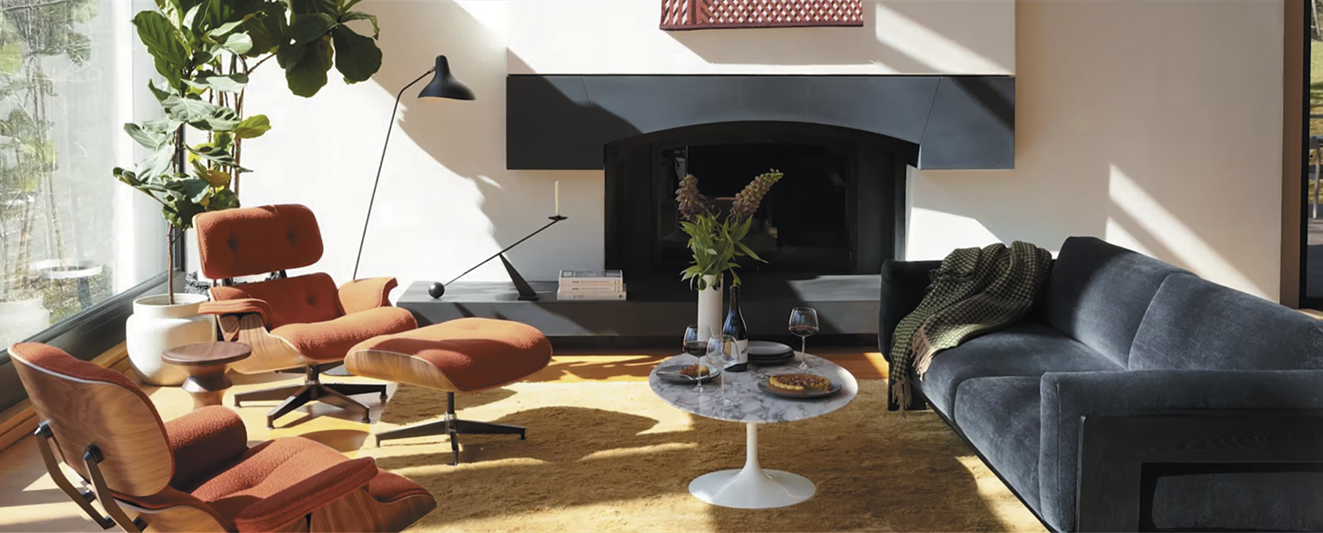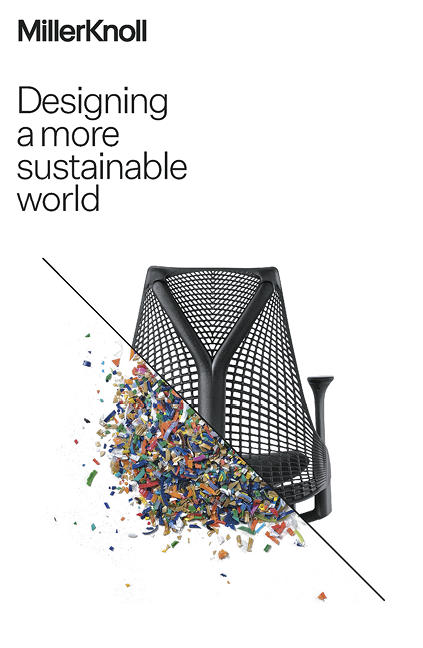- Home
- Media Kit
- MediaJet
- Current Issue
- Past Issues
- Ad Specs-Submission
- Reprints (PDF)
- Photo Specifications (PDF)
- Contact Us
- PRIVACY POLICY
- TERMS OF USE
![]()
ONLINE
![]()
ONLINE

Designing The World We Live In
Editors’ Note
Andi Owen is the Chief Executive Officer and member of the Board of Directors of MillerKnoll, a collective of dynamic brands with nearly 11,000 global employees and revenue of $4.1 billion in fiscal 2023. The firm is a leader in designing and manufacturing environments for work, home and beyond for contract and retail customers around the globe. Owen first joined Herman Miller as President and CEO and was instrumental in guiding the merger of two iconic design companies – Herman Miller and Knoll, along with their specialty brands – to create MillerKnoll. Owen brings a depth of experience driving complex customer-focused businesses to her leadership at MillerKnoll. She is passionate about using design-based thinking to solve complex problems, innovating to improve people’s lives, and using business as a force for good. This core belief informs her overall strategy and vision for the company. Owen is a committed advocate for advancing change. As CEO, she champions MillerKnoll’s efforts to create positive industry and societal change through philanthropy, sustainable and inclusive design, and collective action. Under her leadership, MillerKnoll shapes the conversation on designing spaces that align with how we will live, work, and gather in the future.
Company Brief
MillerKnoll (millerknoll.com) is a collective of dynamic brands that comes together to design the world we live in. The MillerKnoll brand portfolio includes Herman Miller, Knoll, Colebrook Bosson Saunders, DatesWeiser, Design Within Reach, Edelman, Geiger, HAY, Holly Hunt, Knoll Textiles, Maharam, Muuto, NaughtOne, and Spinneybeck|FilzFelt. MillerKnoll is an unparalleled platform that redefines modern for the 21st century by building a more sustainable, equitable and beautiful future for all.

MillerKnoll high-quality furniture components
Will you discuss the merger of MillerKnoll and how you define the company’s mission?
Herman Miller and Knoll merged in 2021, forming the design collective now known as MillerKnoll. Merging these iconic brands together was both an incredibly exciting move, and a very natural one. Both have been undeniable pioneers in modern design, and now we have the opportunity to bring their legacies into the future, building on and honoring the solid foundations each brand has built.
Now, as one collective, we’re committed to designing the world we live in, and building a more sustainable, equitable, and beautiful future. Our mission, as I define it, is to use our business for the greater good, all while delivering the timeless, quality designs we’re known for.
From a business perspective, merging into one collective has driven our momentum. We’ve expanded our dealer network, bringing new designs to new markets. We’ve focused on our retail expertise, and we’ve connected with a greater number of designers and forged new collaborations, increasing our global impact to help create innovative and inclusive spaces.
Beyond the shared history and design legacy that brought Herman Miller and Knoll together, we also knew that contractions were coming for our industry. Even before the pandemic, office space dynamics were changing. While the pandemic accelerated remote work, distributed teams, and has fundamentally changed how we exist in our working and living spaces, we knew that these headwinds were already coming for our industry. Merging allowed us to benefit from the collective strength of our combined brands to continue delivering for our customers and clients.

MillerKnoll furniture
What have been the keys to MillerKnoll’s industry leadership and how do you describe the MillerKnoll difference?
Herman Miller and Knoll have long been pioneers in the design industry. Our industry leadership has been built on pushing the boundaries, and asking ourselves how we can design what the world will look like tomorrow, as opposed to solely reacting to the needs and tastes we see in spaces today. And now, as one collective, we’re continuing that legacy.
As for the MillerKnoll difference – we’re incredibly fortunate when it comes to the brands within our collective. From our most recognized consumer brands – Herman Miller, Knoll, and Design Within Reach – to amazing specialty brands – including HAY, Muuto, Holly Hunt, NaughtOne and more – delivering to niche and bespoke markets, we’re able to design for retail and contract customers, in a variety of different settings (home, office, government, hospitality, healthcare, and more), and on a global scale.
We are constantly learning and growing from each other as we collaborate across our brands, integrating what makes each one unique into our overall ethos as a company. When you combine our brand legacy with the agility and innovation brought by our smaller brands, you can really see what sets us apart from our peers.

How is MillerKnoll redefining modern design?
MillerKnoll is built on the legacy our founding brands have laid, as pioneers and disruptors in modern design, building spaces that people love. Our mission is to design for today and tomorrow, and to create spaces that meet our modern needs while also pushing us forward into the future.
Right now, we believe that means reintroducing the human experience back into modern design. We’re focused on creating products and spaces for the entire person, for the holistic experience they have every day, not just a specific function or task. So, for example, creating furniture for the office that takes into account how different employees might use their workspace – do they need products that can be easily rearranged to collaborate? What about designing the office to better adapt to hybrid work?
Pushing modern design into the future also means leveraging the emerging tools we have today to create beautiful spaces tomorrow. We’re always focused on identifying and seizing new opportunities to improve our design process, as well as help our customers and clients visualize our pieces in their lives.
At the same time, we’re also redefining modern design to be a tool for the greater good, and pushing our industry partners and peers to do the same. Whether it be using recycled and sustainable materials or designing for different physical, mental, emotional, or cultural needs, we know our built environment isn’t something adjacent to how we live our lives, but rather something that shapes it. As one collective, we’re working each day to create spaces that are a net positive experience for everyone.
How can business leaders reimagine their workplaces to embrace the new ways we live and work?
Everything about the ways we live and work has changed, and we need workplaces that reflect that evolution. Hybrid working conditions have changed how often we see our colleagues, and altered how we collaborate. We’ve also learned how the “traditional” approach – where an office is just a space to complete tasks – can often make the workplace experience difficult and isolating for many employees.
We need workplaces that empower a diverse workforce – representing different physical and mental needs, cultural experiences, and personal backgrounds – to achieve and excel. We need to adapt our spaces, not continue expecting employees to adapt to the office. This doesn’t have to be intimidating. CEOs have a once-in-a-generation opportunity to remove exclusionary barriers in the workplace, and make the office accessible, inclusive, and impactful for everyone.
What are the return-to-office trends MillerKnoll is focused on, and what insights are you providing to clients?
When it comes to the return-to-work conversation, we’re focused on what happens after we all gather back in the office. We know that employees want to feel connected to their colleagues, and sense that they belong. While we want to design spaces that encourage people to spend time in the office, we also want to create workplaces that are wellness driven and create a positive and impactful experience for employees.
We’ve long been focused on creating inclusive workplaces, and over the decades we’ve spent in this space, we’ve learned that the most important stakeholders in the designing process are employees. You cannot reimagine the workplace without first understanding how the needs of your workforce may have changed. So, with that in mind, the first and most important step in redesigning the workplace is listening to employees’ needs, and from there, curating an environment that supports them and is adaptable to the changes of tomorrow.
Beyond fostering community and connection, we’re also keenly aware that the workplace must be flexible. Hybrid and remote work have altered how often employees are in the office, and pushed companies to embrace change and accept flexible work arrangements. We need spaces that reflect this adaptability.
Building flexible spaces that support employees when and where they work, and that can be quickly and easily reconfigured to fit different team dynamics and projects, is part of creating an organizational culture that is resilient to change, and accessible to everyone.
How critical is it for MillerKnoll to build a diverse and inclusive workforce to mirror the diversity of its clients and the communities it serves?
Belonging is integral to everything we are and everything we do. We serve so many different communities around the world, and it’s essential that we build a workforce that mirrors those who are using our products to bring their spaces to life.
I’m proud that, as we design spaces where everyone can thrive, we’re equally committed to leading by example. It’s more than just maintaining a diverse workforce to design useful products, however – it’s also about a core belief that MillerKnoll should be somewhere that everyone can belong. And I’m happy to report that we’ve been consistently recognized as such. Just this year, we were recognized by Newsweek as one of America’s Greatest Workplaces for Diversity, and we earned a top score from the Human Rights Campaign’s Corporate Equality Index.
Our engagement with the broader industry is the same. As a global company, we design for communities all over the world, and it’s so important that every step in the process reflects that. Our workforce is more than just our designers and associates. We also work with a fantastic supplier network, which we work hard to make sure includes diverse partners and enterprises, and creates opportunities for underrepresented communities.
We also talk about designing for the whole person, and creating spaces that positively impact the world around us. To do that, we have to ensure our designs meet diverse needs, backgrounds, and experiences. We are passionate advocates for including broad perspectives in our design process, and throughout our organization.
As part of that commitment, we established the Diversity in Design Collaborative (DID), bringing together companies from across the design industry to break down educational and career barriers to Black creatives throughout the talent pipeline. We knew that lasting change wouldn’t come from us acting alone, but rather working together as one industry to move the needle and push for better representation across the board.
What do you see as MillerKnoll’s responsibility to be a good corporate citizen and to address societal need?
For us, giving back to our communities is another core value. It’s important to us – and to me personally – that we use our business for the greater good, whether that be reaching out to our communities or making sure we deliver for our customers in a sustainable and equitable way.
When the initial opportunity to join Herman Miller came around, one of the deciding factors for me was the chance to work for a company aligned with my values – working for a company creating pieces that would last generations, not end up in landfill. Not only have I long been passionate about protecting our planet, but I had spent my career in the retail industry, and I didn’t want to keep inadvertently contributing to waste. Now, in leading MillerKnoll, I intend to continue that legacy and ensure MillerKnoll is always a leader not only in caring for the environment, but for our society as a whole.
First and foremost are our operations – our design process, our dealer network, and our distribution. Corporate citizenship starts in how we do our business, and at MillerKnoll it’s critical that we can advance change at every step. That’s why we’ve made an effort to design out waste by using recycled and sustainable materials, reduce our carbon emissions to meet the U.N.’s 2023 goals, and keep our products out of landfills by giving our customers sustainable, alternative options for discarding pieces they no longer need. With these and every other initiative, we’re making good on our responsibility to protect the planet and do business in a way that’s better for everyone.
But our responsibility goes beyond our products. We as a company have the reach to make tangible and sustainable change for communities worldwide, and we feel an obligation to leverage that in any and every way we can.
Every year, we celebrate our global Day of Purpose, a day all colleagues are encouraged to spend time giving back to their communities, and for our U.S. colleagues to participate in local elections as well. It’s always amazing to see not only how our brands participate and the tangible good we can do as one collective, but also how much each colleague within MillerKnoll takes our commitment to heart.
What is next for MillerKnoll, and what are the opportunities you are looking forward to for the collective?
I’m looking forward to the work we’re doing as a collective to cement our legacy, and continue disrupting the industry with innovative yet timeless designs. Our industry is at an inflection point, and we have an incredible opportunity to completely reimagine how spaces play a role in our lives.
Something particularly exciting for us right now is what lies beyond the home and office. Our lives take place in so many different environments. And not every workplace is a traditional office. Inclusive design is meant for any and all spaces, and we’re focused on maximizing opportunities to bring that intention beyond the home and office.
Take, for example, the healthcare industry. Designing our hospitals and care facilities with intention not only plays an important role in our healthcare experience, but also in ensuring agility and resilience in our health systems. From products that can be easily repurposed to spaces that are inclusive, accessible, and comfortable for patients and staff with different needs, we’re looking at the healthcare system to see how we can bring these spaces to life with innovative design, keeping hospitality at the core.
It’s opportunities like this – analyzing the entire human experience and how it can be improved with intentional and inclusive design – that I’m most excited about for our collective.
What do you feel are the keys to effective leadership?
To me, empathy and compassion are two essential qualities for effective leadership. For everyone – your colleagues, your customers, your community. Being able to understand and validate the situations or emotions those around you are dealing with is critical to strong leadership. I’ve found that the best way to exercise that skill is to listen.
Especially now, when modern leaders are working to bring people together when they’re far apart or even isolated, and to motivate each other through complex situations, it’s vital that we as leaders are able to listen and learn. I’ve learned that we must always be willing to adapt, and communicate and lead in the ways our team members need – not the way we want to or the way we feel the most comfortable. So, in addition to empathy and compassion, effective leadership requires us to listen, embrace feedback, and push ourselves to grow in the ways our people need us to.
What advice do you offer to young people beginning their careers?
Don’t be afraid to speak up and rock the boat. When you’re starting out in your career – especially for those coming into their first leadership positions – you have a fresh perspective on everything around you. Take advantage of that, and pursue change. Find what’s not working – or what could work better – and seize the opportunity to transform what’s in front of you. Learn from the wisdom of others, yes, but don’t discount your ideas simply because you’re young.![]()